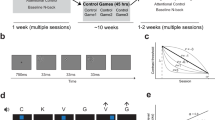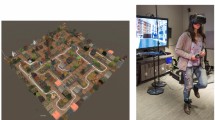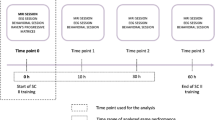Abstract
The hippocampus is critical to healthy cognition, yet results in the current study show that action video game players have reduced grey matter within the hippocampus. A subsequent randomised longitudinal training experiment demonstrated that first-person shooting games reduce grey matter within the hippocampus in participants using non-spatial memory strategies. Conversely, participants who use hippocampus-dependent spatial strategies showed increased grey matter in the hippocampus after training. A control group that trained on 3D-platform games displayed growth in either the hippocampus or the functionally connected entorhinal cortex. A third study replicated the effect of action video game training on grey matter in the hippocampus. These results show that video games can be beneficial or detrimental to the hippocampal system depending on the navigation strategy that a person employs and the genre of the game.
This is a preview of subscription content, access via your institution
Access options
Subscribe to this journal
Receive 12 print issues and online access
$259.00 per year
only $21.58 per issue
Buy this article
- Purchase on Springer Link
- Instant access to full article PDF
Prices may be subject to local taxes which are calculated during checkout




Similar content being viewed by others
References
Zimbardo PG, Duncan N. The Demise of Guys: Why Boys Are Struggling and What We Can Do About It. Ireland Books, 2012.
West GL, Stevens SA, Pun C, Pratt J. Visuospatial experience modulates attentional capture: evidence from action video game players. J Vis 2008; 8: 13 1–9.
Dye MW, Green CS, Bavelier D. The development of attention skills in action video game players. Neuropsychologia 2009; 47: 1780–1789.
Green CS, Bavelier D. Action video game modifies visual selective attention. Nature 2003; 423: 534–537.
Blacker KJ, Curby KM. Enhanced visual short-term memory in action video game players. Atten Percept Psychophys 2013; 75: 1128–1136.
Green CS, Sugarman MA, Medford K, Klobusicky E, Daphne B. The effect of action video game experience on task-switching. Comput Human Behav 2012; 28: 984–994.
Bavelier D, Green CS, Pouget A, Schrater P. Brain plasticity through the life span: learning to learn and action video games. Annu Rev Neurosci 2012; 35: 391–416.
Gozli DG, Bavelier D, Pratt J. The effect of action video game playing on sensorimotor learning: evidence from a movement tracking task. Hum Mov Sci 2014; 38C: 152–162.
Kuhn S, Gleich T, Lorenz RC, Lindenberger U, Gallinat J. Playing Super Mario induces structural brain plasticity: gray matter changes resulting from training with a commercial video game. Mol Psychiatry 2014; 19: 265–271.
West GL, Drisdelle BL, Konishi K, Jackson J, Jolicoeur P, Bohbot VD. Habitual action video game playing is associated with caudate nucleus-dependent navigational strategies. Proc Biol Sci 2015; 282: 20142952.
Kuhn S, Gallinat J. Amount of lifetime video gaming is positively associated with entorhinal, hippocampal and occipital volume. Mol Psychiatry 2013; 19: 842–847.
Pantelis C, Velakoulis D, McGorry PD, Wood SJ, Suckling J, Phillips LJ et al. Neuroanatomical abnormalities before and after onset of psychosis: a cross-sectional and longitudinal MRI comparison. Lancet 2003; 361: 281–288.
Apostolova LG, Dutton RA, Dinov ID, Hayashi KM, Toga AW, Cummings JL et al. Conversion of mild cognitive impairment to Alzheimer disease predicted by hippocampal atrophy maps. Arch Neurol 2006; 63: 693–699.
Hill DL, Schwarz AJ, Isaac M, Pani L, Vamvakas S, Hemmings R et al. Coalition Against Major Diseases/European Medicines Agency biomarker qualification of hippocampal volume for enrichment of clinical trials in predementia stages of Alzheimer's disease. Alzheimers Dement 2014; 10: 421–429.e3.
Amico F, Meisenzahl E, Koutsouleris N, Reiser M, Moller HJ, Frodl T. Structural MRI correlates for vulnerability and resilience to major depressive disorder. J Psychiatry Neurosci 2011; 36: 15–22.
Lerch JP, Yiu AP, Martinez-Canabal A, Pekar T, Bohbot VD, Frankland PW et al. Maze training in mice induces MRI-detectable brain shape changes specific to the type of learning. Neuroimage 2011; 54: 2086–2095.
Bohbot VD, Lerch J, Thorndycraft B, Iaria G, Zijdenbos AP. Gray matter differences correlate with spontaneous strategies in a human virtual navigation task. J Neurosci 2007; 27: 10078–10083.
Iaria G, Petrides M, Dagher A, Pike B, Bohbot VD. Cognitive strategies dependent on the hippocampus and caudate nucleus in human navigation: variability and change with practice. J Neurosci 2003; 23: 5945–5952.
Bohbot VD, McKenzie S, Konishi K, Fouquet C, Kurdi V, Schachar R et al. Virtual navigation strategies from childhood to senescence: evidence for changes across the life span. Front Aging Neurosci 2012; 4: 28.
Maguire EA, Gadian DG, Johnsrude IS, Good CD, Ashburner J, Frackowiak RS et al. Navigation-related structural change in the hippocampi of taxi drivers. Proc Natl Acad Sci USA 2000; 97: 4398–4403.
Nadel L, Hoscheidt S, Ryan LR. Spatial cognition and the hippocampus: the anterior-posterior axis. J Cogn Neurosci 2013; 25: 22–28.
O'Keefe J, Nadel L. The Hippocampus As A Cognitive Map. Clarendon: Oxford, 1978.
Bliss TV, Collingridge GL. A synaptic model of memory: long-term potentiation in the hippocampus. Nature 1993; 361: 31–39.
McEwen BS, Eiland L, Hunter RG, Miller MM. Stress and anxiety: structural plasticity and epigenetic regulation as a consequence of stress. Neuropharmacology 2012; 62: 3–12.
Mishkin M, Petri HL. Memories and habits: some implications for the analysis of learning and retentionButters INeuropsychology of Memory. Guilford: New York, 1984; 287–296.
Squire LR, Zola SM. Structure and function of declarative and nondeclarative memory systems. Proc Natl Acad Sci USA 1996; 93: 13515–13522.
Etchamendy N, Bohbot VD. Spontaneous navigational strategies and performance in the virtual town. Hippocampus 2007; 17: 595–599.
Poldrack RA, Clark J, Pare-Blagoev EJ, Shohamy D, Creso Moyano J, Myers C et al. Interactive memory systems in the human brain. Nature 2001; 414: 546–550.
Bohbot VD, Del Balso D, Conrad K, Konishi K, Leyton M. Caudate nucleus-dependent navigational strategies are associated with increased use of addictive drugs. Hippocampus 2013; 23: 973–984.
Bavelier D, Davidson RJ. Brain training: games to do you good. Nature 2013; 494: 425–426.
Belchior P, Marsiske M, Sisco SM, Yam A, Bavelier D, Ball K et al. Video game training to improve selective visual attention in older adults. Comput Human Behav 2013; 29: 1318–1324.
Schwabe L, Oitzl MS, Philippsen C, Richter S, Bohringer A, Wippich W et al. Stress modulates the use of spatial versus stimulus-response learning strategies in humans. Learn Mem 2007; 14: 109–116.
Ledoux AA, Boyer P, Phillips JL, Labelle A, Smith A, Bohbot VD. Structural hippocampal anomalies in a schizophrenia population correlate with navigation performance on a wayfinding task. Front Behav Neurosci 2014; 8: 88.
Ashburner J, Friston KJ. Voxel-based morphometry—the methods. Neuroimage 2000; 11(6 Pt 1): 805–821.
Sadedin SP, Pope B, Oshlack A. Bpipe: a tool for running and managing bioinformatics pipelines. Bioinformatics 2012; 28: 1525–1526.
Yoon U, Fonov VS, Perusse D, Evans AC, Brain Development Cooperative G. The effect of template choice on morphometric analysis of pediatric brain data. Neuroimage 2009; 45: 769–777.
Eskildsen SF, Coupe P, Fonov V, Manjon JV, Leung KK, Guizard N et al. BEaST: brain extraction based on nonlocal segmentation technique. Neuroimage 2012; 59: 2362–2373.
Filippi M, Horsfield MA, Hajnal JV, Narayana PA, Udupa JK, Yousry TA et al. Quantitative assessment of magnetic resonance imaging lesion load in multiple sclerosis. J Neurol Neurosurg Psychiatry 1998; 64(Suppl 1): S88–S93.
Konishi K, Bohbot VD. Spatial navigational strategies correlate with gray matter in the hippocampus of healthy older adults tested in a virtual maze. Front Aging Neurosci 2013; 5: 1.
West GL, Konishi K, Bohbot VD. Video games and hippocampus-dependent learning. Curr Dir Psychol Sci 2017; 26: 152–158.
Hasan Y, Begue L, Bushman BJ. Violent video games stress people out and make them more aggressive. Aggress Behav 2013; 39: 64–70.
Ivarsson M, Anderson M, Akerstedt T, Lindblad F. The effect of violent and nonviolent video games on heart rate variability, sleep, and emotions in adolescents with different violent gaming habits. Psychosom Med 2013; 75: 390–396.
Kim JJ, Lee HJ, Han JS, Packard MG. Amygdala is critical for stress-induced modulation of hippocampal long-term potentiation and learning. J Neurosci 2001; 21: 5222–5228.
Pavlov IP. Conditioned Reflexes. Oxford University Press: Oxford, 1927.
Cohen NJ, Poldrack RA, Eichenbaum H. Memory for items and memory for relations in the procedural/declarative memory framework. Memory 1997; 5: 131–178.
Tulving E, Markowitsch HJ. Episodic and declarative memory: role of the hippocampus. Hippocampus 1998; 8: 198–204.
Woollett K, Maguire EA. Acquiring "the Knowledge" of London's layout drives structural brain changes. Curr Biol 2011; 21: 2109–2114.
Bohbot VD, Gupta M, Banner H, Dahmani L. Caudate nucleus-dependent response strategies in a virtual navigation task are associated with lower basal cortisol and impaired episodic memory. Neurobiol Learn Mem 2011; 96: 173–180.
Lupien SJ, de Leon M, de Santi S, Convit A, Tarshish C, Nair NP et al. Cortisol levels during human aging predict hippocampal atrophy and memory deficits. Nat Neurosci 1998; 1: 69–73.
Du AT, Schuff N, Kramer JH, Ganzer S, Zhu XP, Jagust WJ et al. Higher atrophy rate of entorhinal cortex than hippocampus in AD. Neurology 2004; 62: 422–427.
Konishi K, Etchamendy N, Roy S, Marighetto A, Rajah N, Bohbot VD. Decreased functional magnetic resonance imaging activity in the hippocampus in favor of the caudate nucleus in older adults tested in a virtual navigation task. Hippocampus 2013; 23: 1005–1014.
Etchamendy N, Konishi K, Pike GB, Marighetto A, Bohbot VD. Evidence for a virtual human analog of a rodent relational memory task: a study of aging and fMRI in young adults. Hippocampus 2012; 22: 869–880.
Basak C, Boot WR, Voss MW, Kramer AF. Can training in a real-time strategy video game attenuate cognitive decline in older adults? Psychol Aging 2008; 23: 765–777.
Lovden M, Schaefer S, Noack H, Bodammer NC, Kuhn S, Heinze HJ et al. Spatial navigation training protects the hippocampus against age-related changes during early and late adulthood. Neurobiol Aging 2012; 33: 620.e9–e22.
Belleville S, Clement F, Mellah S, Gilbert B, Fontaine F, Gauthier S. Training-related brain plasticity in subjects at risk of developing Alzheimer's disease. Brain 2011; 134(Pt 6): 1623–1634.
Gilbertson MW, Shenton ME, Ciszewski A, Kasai K, Lasko NB, Orr SP et al. Smaller hippocampal volume predicts pathologic vulnerability to psychological trauma. Nat Neurosci 2002; 5: 1242–1247.
Swan GE, Lessov-Schlaggar CN. The effects of tobacco smoke and nicotine on cognition and the brain. Neuropsychol Rev 2007; 17: 259–273.
Acknowledgments
We would like to thank the Fonds de Recherche du Québec—Nature et Technologies for supporting this research. We would also like to thank Jean-Marc Therrien-Blanchet, Marie C. Ferland, Simon Delorme, Gasser Saleh, Hadrien Laforest, Philippe Des Roches and Jamila Amirova for their help with data collection.
Author information
Authors and Affiliations
Corresponding authors
Ethics declarations
Conflict of Interest
The authors declare no conflict of interest.
Electronic supplementary material
Rights and permissions
About this article
Cite this article
West, G.L., Konishi, K., Diarra, M. et al. Impact of video games on plasticity of the hippocampus. Mol Psychiatry 23, 1566–1574 (2018). https://doi.org/10.1038/mp.2017.155
Received:
Revised:
Accepted:
Published:
Issue Date:
DOI: https://doi.org/10.1038/mp.2017.155
This article is cited by
-
Extensive long-term verbal memory training is associated with brain plasticity
Scientific Reports (2021)
-
Memorization of daily routines by children with Down syndrome assisted by a playful virtual environment
Scientific Reports (2020)
-
Playing Super Mario increases oculomotor inhibition and frontal eye field grey matter in older adults
Experimental Brain Research (2019)
-
An Expectancy Effect Causes Improved Visual Attention Performance After Video Game Playing
Journal of Cognitive Enhancement (2019)
-
Hippocampal–caudate nucleus interactions support exceptional memory performance
Brain Structure and Function (2017)



